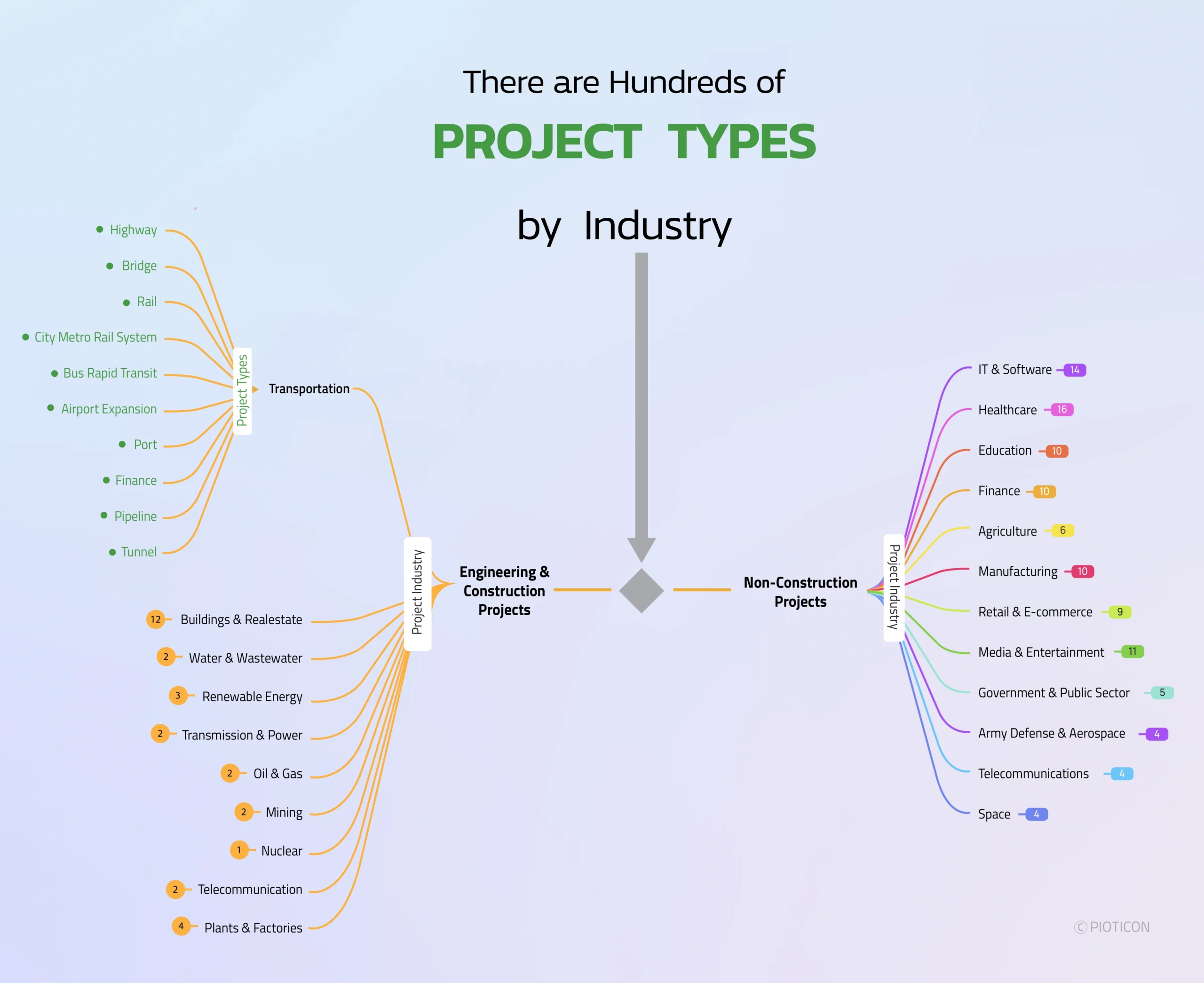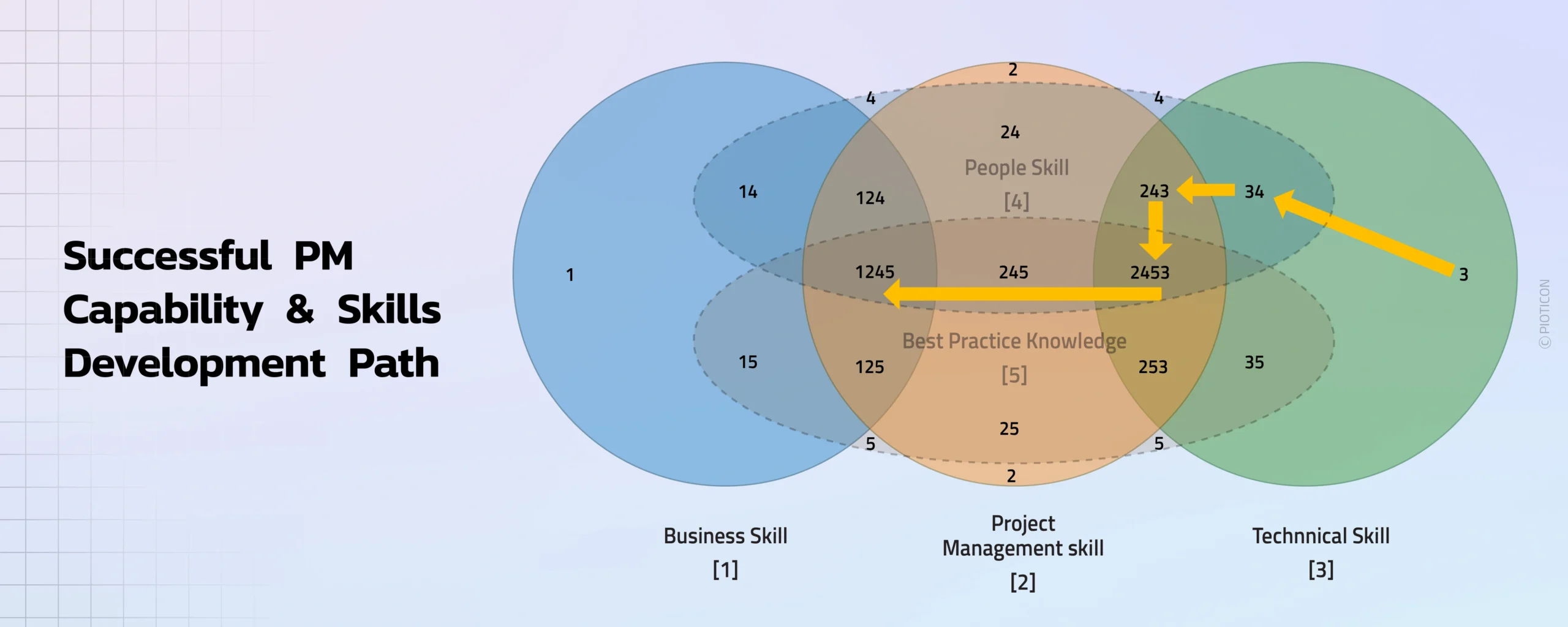- 28 May 2025
- Madan G Anand
- 0
Generic Project Management Kills Its Own Purpose
Project management today is flooded with frameworks, content, and advice, much of it well-meaning, but often disconnected from the realities of delivery. Across platforms like LinkedIn and mainstream certification programs, a wave of generic project management thinking has emerged. It’s creating more noise than clarity, and in doing so, it’s slowly eroding the value of project management itself.
Projects vary, not just by size or duration, but by industry, complexity, delivery model, and context. And each of those variables demands a tailored approach, not a standardised one.
Why Project Type Matters More Than Most Acknowledge
A glance at the project landscape quickly reveals its diversity. As illustrated in the visual mapping of hundreds of project types by industry, Engineering & Construction Projects (e.g., highways, tunnels, power plants) differ fundamentally from Non-Construction Projects (e.g., IT implementations, finance system rollouts, media production). And even within Engineering & Construction, a highway project is not the same as a high-rise tower or an underground metro system.
Hundreds of Project Types
Despite this, project management advice is often treated as one-size-fits-all. The result? Misalignment, reduced effectiveness, and repeated delivery failures.
While generic project management principles can offer a foundational starting point, they fall short when complexity increases and sector-specific realities come into play. Each project type, and often, each sub-type, requires its own blend of methodology, leadership, and controls.
Management Capability Must Reflect Project Reality
To effectively deliver these diverse project types, the capability of the project manager and the structure of the management team must evolve accordingly.
The graphic below outlines a structured hierarchy of project management categories from project-level to portfolio-level, and illustrates how roles and responsibilities shift across Owners/Client Representatives, Engineering Consultants, Principal Contractors, and Subcontractors in mega or major projects.
Competency requirements across these roles vary not just by level, but by project category and type. Misunderstanding this often leads to a poor fit between management approach and project demands.
The Myth of Seamless Transition into Project Management
A persistent and damaging assumption in the industry is that successful engineers or construction managers can naturally transition into project management roles.
This thinking fails to acknowledge a critical truth:
“The skills required to construct a bridge are not the same as those needed to manage a bridge project to time, cost, scope, and quality targets.”
Project managers require a deep understanding of planning, monitoring techniques, systems, controls, risk, stakeholder alignment, and commercial drivers, not just technical know-how to design or build.
These misunderstanding fuels the rise of the “accidental project manager”—someone promoted based on just engineering or operational experience, rather than on their ability to manage the full complexity of a project lifecycle.
Why Generic Tools and Systems Fall Short
Not only are people misaligned to roles, but so are the tools they’re handed. Project management systems and software that work well for real estate high-rise building towers often fall short in linear infrastructure like highways, rail, or pipelines.
While certain work or trade packages, like concrete or electrical, may appear similar across projects, they account for only a fraction of total complexity. Delivery environments, stakeholder interfaces, and risk profiles vary greatly.
The widespread promotion of generic project management platforms and playbooks glosses over these nuances and creates a false sense of readiness.
The Competency Blend That Actually Delivers
At Pioticon, we emphasize a structured approach to building real capability. Based on our work in engineering and construction, we focus on five core skill domains:
- Business Skills [The know-why behind the work]
- Project Management Skills [The know-how to make the work happen successfully]
- Technical Skills (Engineering, Design, Construction) [The know-how to do the work]
- People Skills [The know-how to lead and influence people to perform]
- Best Practice Knowledge [The know-what and why behind doing things the right way]
The visual framework below illustrates how these domains overlap. While few individuals possess all five at once, the most successful professionals in construction project management evolve along a deliberate path, starting from a strong technical base and progressively building business acumen, leadership capability, and project delivery systems thinking.
| Project Management Categories by Industry and Project Type | Project Leader Role Examples^ | Required Skill* Domains with Appropriate Maturity Level. |
|---|---|---|
| Cat-1 | COO, GM or Project Director | [1] Business [2] Project Management [4] People Skills [5] Best Practice Knowledge |
| Cat-2 | Program Manager, Operations Manager or Project Director | [1] Business [2] Project Management [4] People Skills [5] Best Practice Knowledge |
| Cat-3 | Owner Project Manager | [2] Project Management [4] People Skills [5] Best Practice Knowledge |
| Cat-4E | Engineering/Design Project Manager/Director | [2] Project Management [3] Technical [4] People Skills [5] Best Practice Knowledge |
| Cat-4C | Construction Contractor’s Project Manager/Director | [2] Project Management [3] Technical [4] People Skills [5] Best Practice Knowledge |
| Cat-5Cp | Construction Delivery Section/Package Manager/Sr.Project Engineer | [2] Project Management [3] Technical [4] People Skills |
| Cat-5Cs | Sub-Contractor PM | [3] Technical [4] People Skills |
*Technical skills for Categories 1-3 are typically developed through progression from other categories during career advancement. Project Management itself has technical elements that are gained from prior Engineering or Construction experience in other categories.
^Categories also apply to Project Management and Control professionals, including Project Controls, Planning & Scheduling, Cost Engineering & Estimation, Risk, and Reporting.
These skills are essential for productive technical leadership in high-complexity projects. This integration of knowledge is where project control becomes proactive, not reactive. It’s what` enables PMs to navigate scope creep, shifting conditions, and cross-functional pressures.
Purpose-Built for Engineering & Construction
At Pioticon, we don’t just believe in tailored project management, we build for it. Our focus remains on Engineering & Construction projects because they require sector-specific systems, delivery-aligned teams, and capability development rooted in real-world complexity.
We’re not here to offer templates.
We’re here to offer purpose-built systems, tools, techniques and thinking built for the job at hand.
Final Word
Generic project management can actively derail project success by creating false confidence, mismatched expectations, and ineffective leadership paths.
To achieve performance in complex environments, we must stop treating project management as a universal solution and start treating it as a purpose-built capability, developed in context, for context.

